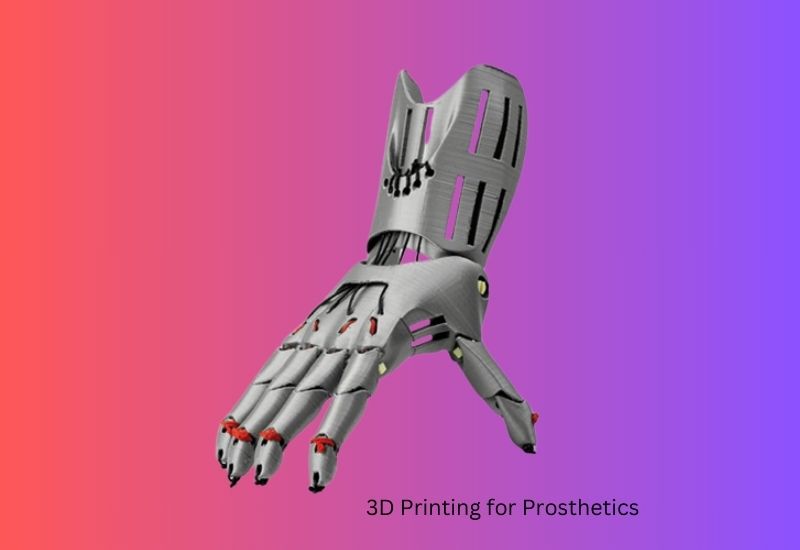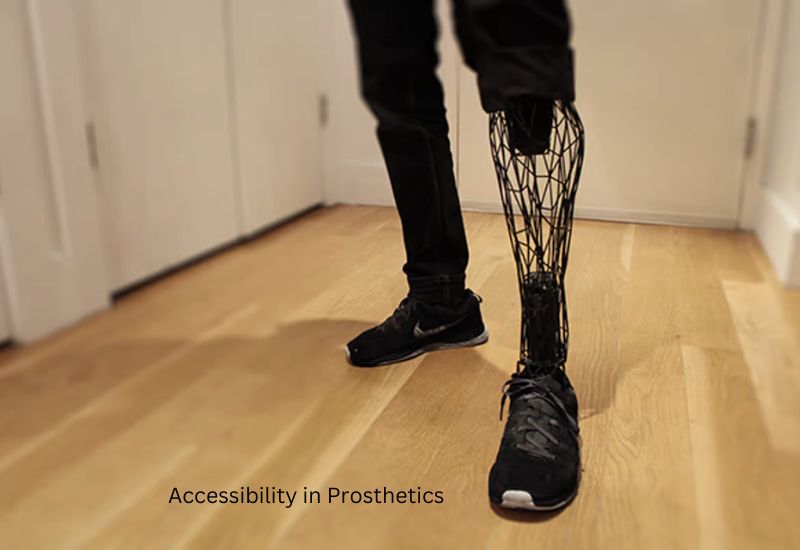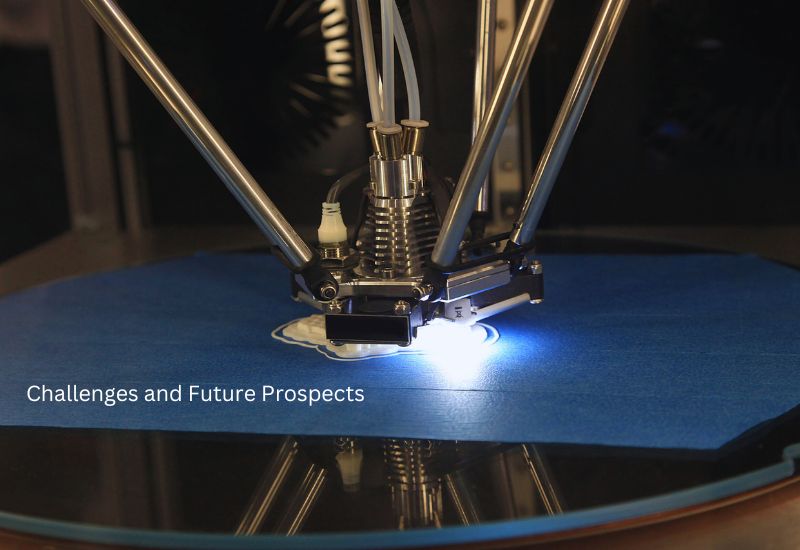3D printing in prosthetics: In the prosthetics industry, 3D printing stands to benefit significantly, offering numerous advantages on a larger scale. I am familiar with 3D printing and have a better understanding of its benefits.
The global Market for 3D-printed prosthetic devices is expected to reach $1.13 billion by 2024, growing at a compound annual growth rate (CAGR) of 8.8%. As a result, investors are more likely to invest in this sector.

The Benefits of 3D Printing for Prosthetics
Customization and Personalization
Using 3D printing technology, prosthetic devices can be designed based on an individual’s anatomy, offering customers unmatched benefits. Each device is fully functional, enabling a degree of individualized personalization.
Designers can use sophisticated scanners to capture a limb’s geometry and copy it to a computer for accurate limb dimensions and shape. As the prosthetic correlates with the user’s body, it becomes more comfortable.
A 3D-printed prosthetic can also be customized by the wearer with a variety of designs and color options, turning it into a personal statement. Allied health providers and patients alike value these prosthetics for their accurate fit and artistic appeal. For creators, this type of custom work can also be a unique way to make money from a 3D printer by offering personalized, functional designs that truly stand out.
Cost-Effectiveness and Affordability
Prosthetics are increasingly expensive in most cases. They amount to thousands of dollars and are made with a great deal of time and effort. In comparison, 3D-printed prosthetics are more affordable. A 3D-printed arm will cost over $395. They are manufactured cost-effectively because there is no material waste and no need for molds. 3D printing is an excellent option because it is cost-effective and time-saving for all stakeholders. Instead of weeks, prostheses can be ready in just days.
Speed and Efficiency
3D printing fundamentally changes the process of fabricating prostheses by significantly reducing production times. With 3D printing technology for medical applications scattered worldwide, prostheses that would typically take weeks to manufacture and fit can now be produced within days.
This time-saving technology streamlines the entire delivery process, allowing active patients to return to their daily lives more quickly. It’s also a wise choice for clinics using the best 3d printer for small business, helping them produce custom parts faster and more affordably.
3D-printed devices improve patient satisfaction by meeting patients’ needs. During her P stage, rapid prototyping enabled her to create and modify nearly all of the design configurations. Thus, patients now have access to an effective spinal prosthesis.
With rapid production, patients can express their opinions on the device and obtain a prototype within a few hours, increasing patient satisfaction. As the rehabilitation industry shifts towards enhanced applications, 3D printing practices are expected to speed up bulk production and reduce costs.
Advances in 3D Printed Prosthetic Designs
Innovative Materials and Designs
As prosthetics become more complex, new technologies such as nylon, carbon fiber, and PEEK (Polyetheretherketone) are being developed to enhance functionality and improve ease of use. Carbon fiber’s superior weight-to-strength ratio makes it easy to create strong and lightweight limbs. Nylon adds flexibility and strength to parts that require more elasticity, while PEEK provides strength and resistance due to its high strength.
Most of all, these materials allow us to design products that look and feel more like real limbs. Thanks to the more advanced materials used in 3D-printed prosthetics, everyday activities are easier and more comfortable. As technology progresses, more unique designs will emerge by combining artificial and natural limbs.
Integration of Technology
When engineers integrate advanced technology into artificial limbs, they enable them to function like natural ones. As a result, sensors and electronics equip prosthetics, allowing users to operate them seamlessly. Myoelectric prosthetics utilize signals from the residual limb to control the prosthetic, making them feel natural and comfortable to use.
3D printing has enabled the incorporation of electric sensors into prosthetics. These sensors enhance comfort and allow users to collect data on movement and pressure. Conformal 3D printing places sensors in the fitting area of the prosthesis, resulting in a natural feel.
Electric-powered prosthetics should be affordable and improve the user experience. The future should bring greater comfort and control to many users of prosthetics.

3D Printing and Accessibility in Prosthetics
Global Impact and Accessibility
3D printing now makes prostheses available worldwide at lower costs, reaching regions where traditional manufacturing cannot. It manufactures artificial limbs quickly and affordably, tailored to individual preferences. It is particularly beneficial to underdeveloped nations, where prosthetics are often challenging to obtain at a reasonable price.
How 3D Printing is Making Prosthetics Accessible Worldwide
Prosthetic devices are being transformed by 3D printing technology, as it enables local production and modification without the need for expensive imports and heavy logistics. By producing them on-site, they minimize waiting periods and drastically reduce costs. Traditional prosthetics are often applicable but too expensive to use in many parts of underdeveloped countries, making this type of access crucial.
Case Studies of Projects in Developing Countries
Several programs demonstrate the possibilities of 3D printing in those regions. For example, the Victoria Hand Project utilizes 3D printers in Nepal and Cambodia to create prosthetic hands for amputees. Making prostheses locally eliminates shipping costs and allows customization, unlike standard prostheses.
ChatGPT can make mistakes. Check important info.
LifeNabled also utilizes a 3D printing machine to efficiently and quickly produce prosthetic sockets tailored to specific patients in Guatemala. By improving the region’s cultural appropriateness, the technology becomes relevant to the ecosystem, resulting in increased patient acceptance and usability.
These initiatives demonstrate the significant impact of 3D printing in further enhancing the existing options available to society’s most vulnerable populations and elevating their standard of living. As technology matures, people will be able to use prosthetics without limitation, and everyone will have access to implants tailored to their specific needs.
DIY 3D Printed Prosthetics
Small businesses and hobbyists can create 3D-printed prosthetics. Innovative companies like e-NABLE share free designs without copyright restrictions. Enthusiasts can 3D print low-cost, personalized prosthetics at home. They can freely modify the files and use them to produce customized prosthetics. With this technology, small businesses and enthusiasts do good while practicing their skills.

Unique Challenges and Future Prospects
Current Limitations
There are many advantages to 3D printing for prosthetics, but there are also many challenges. Choosing the right materials is one of them. If the materials are to remain safe in the body for an extended period, they must be biocompatible. Biocompatible materials are usually expensive and hard to find.
The FDA does not directly regulate 3D printers; instead, it controls the medical devices they produce. As a result, 3D-printed prosthetics must navigate complex regulatory pathways.
3D printing makes it easy to create customized prosthetics; however, not all printed prosthetics are as strong as those made from continuous fiber composites. Technology and materials determine the accuracy of the printing process, ensuring uniformity of the finished product. We must improve these factors for 3D-printed prostheses to become a viable option.
Future Innovations in 3D Printed Prosthetics
Technological advances make 3D-printed prostheses promising and position them as the norm. Biocompatible materials that don’t irritate the skin are essential. By creating prostheses that are closer to the real limb, both organic and synthetic would become more comfortable and practical. With 3D organ printing, patients can tailor organs to meet their specific needs.
3D-printed prosthetics emphasize teamwork. Engineers and doctors are working together to improve them. By combining engineering skills with medical expertise, they can create prosthetics that are both anatomically accurate and practical, seamlessly integrating into a person’s body. Collaboration between these fields will benefit them.
FAQs on 3D Printing in Prosthetics
What are the benefits of 3D-printed prosthetics?
They cost less, build faster, and match your needs precisely.
How much do 3D-printed prosthetics cost?
There are variations in prices, but they are generally more affordable than traditional options.
Can 3D-printed prosthetics be customized?
It is possible to customize how they look and function to fit your body and style.
Are 3D-printed prosthetics strong?
They feel solid and light, and many people praise their durability and comfort.
What is the future of 3D-printed prosthetics?
Engineers and doctors are working together to improve the future. New materials and ideas are improving it.
Wrapping Up
3D printing has revolutionized the prosthetics industry by enhancing insulation and enabling more customized devices for each patient. With more materials available to print organs in the future, there will be more synergies in creativity. 3D printing combines technology with healthcare to provide accessories and devices that meet individual needs with ease.
Read more on this sites
- How Do 3D Printers Work? A Simple Guide to the Basics
- 3D Printed Medical Devices: How They’re Changing Healthcare
- Best 3D Printer for Medical Use: Top Picks for Healthcare Innovation
- Best Software for 3D Printers: Tools to Boost Your Prints
- How to 3D Print: A Beginner’s Guide to Getting Started
- JGMAKER A8S 3D Printer Review: Affordable Power for New Creators
- Flashforge Finder 3 3D Printer Review: User-Friendly and Precise
- Flashforge Foto 9.25 3D Printer Review: Great Resin Printing Value
- Flashforge Foto 8.9 3D Printer Review: Budget Resin Printing That Delivers
- Flashforge Adventurer 3 3D Printer Review: Compact and Easy to Use
- Flashforge Guider IIS 3D Printer Review: Built for Professionals
- Flashforge Guider II 3D Printer Review: Reliable and Industrial-Grade
- Flashforge Adventurer 4 3D Printer Review: Advanced Features in a Compact Design
